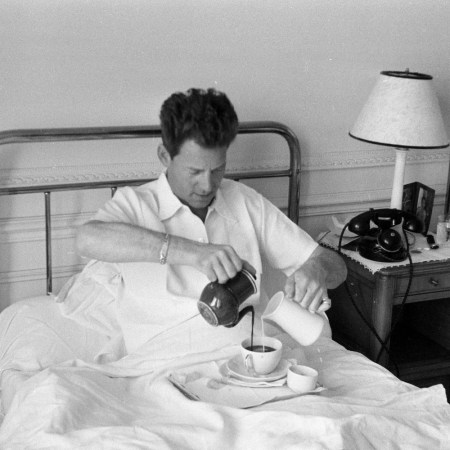In William Finnegan’s memoir Barbarian Days, the surfer and journalist puts his once-splotchy red chest on par with the sublime. “I was a sunburnt pagan now,” he writes. “I felt privy to mysteries.” But there’s enough self-awareness in his exacting, New Yorker-trained prose to recognize the truth: all that time in the sun in the late ’70s probably wasn’t a good idea.
Recounting a trip to Australia, he writes: “The Gold Coast was an object lesson in how I was destroying my body through surfing. Looking around at Australians who spent a lot of time in tropical sun for which they were genetically unprepared — most were of Northern European ancestry — I could see my own sorry medical future … The scabby ears and purple noses and scarily mottled arms of the middle-aged were fair warning: basal-cell carcinoma (if not squamous-cell, if not melanoma) ahead.”
Most men have long entertained a similarly contentious contract with the sun. It is youth, purveyor of good times, the motor to our happiest memories; it’s surfing, but it’s also summer camp, pick-up basketball, sitting in the left-field bleachers at a ballgame. These are situations where young guys are simply having a bit too much fun to be bothered pondering their own mortality. But that contradiction — the sun is fun, the sun is dangerous — is real, and men are dying because of it.
You’d think that, in the 40 years since Finnegan was surf-slumming around the South Pacific, people would’ve learned exactly how to avoid those “purple noses” he clocked along the Gold Coast. And well, we have: dermatology clinics have done yeoman’s work circulating materials on proper sun safety. But rates of melanoma have risen rapidly over the last few decades regardless. Melanoma only accounts for 1% of all skin cancer cases, but it accounts for the majority of skin cancer deaths. That’s because when melanoma is left unchecked and metastasizes, the five-year survival rate nosedives from 99% down to 35%.
Men are not only more likely to develop melanoma than women, we also appear to have a more difficult time catching melanoma before it’s too late. From 1995 to 2014, head and neck melanoma jumped by 51%. More than 60% of those who died from it were young men, especially non-Hispanic white men between the ages of 15 and 39. And making it to middle age is no hall pass to spend the rest of your life at the beach. Relative to gender, the threat only intensifies. As the American Academy of Dermatology reports, “By age 80, men are three times more likely to develop melanoma than women.”
What’s going on here? Why are men so susceptible to melanoma? Is there something going on at the molecular level? Is it simply down to so-called lifestyle choices? What do we need to know? And what do we do in the summer ahead to better protect ourselves against the sun?
The Late-30s Aging Surge: Why It Happens and What to Do
You can’t stop aging, but you can slow it down. Here’s a five-step protocol — for your heart, muscles, skin, cells and brain — that actually works.Why Men Don’t Take Sun Safety Seriously
According to Dr. Chun Tang, a general practitioner at Pall Mall Medical in the U.K., the gap in melanoma deaths between the genders starts with an information gap. “There is a lower awareness and understanding amongst young men regarding the facts of skin cancer,” he says. “The American Academy of Dermatology found that, in comparison to women, men had less knowledge of the dangers posed by skin cancer, specifically related to tanning facts. Women are more likely to apply sun cream, particularly given that lots of makeup products now include SPF protection.”
As it turns out, broad male stereotypes do play a role in today’s skin cancer epidemic. Men frequently take their shirts off (or wear tank-tops) for activities like running or gardening. Too often, at outdoor job sites, golf outings or fishing trips, they employ a sort of “rub some dirt on it” stoicism, instead of…rubbing some sunscreen on it. And men are comfortable equating sun lotion with all the other cosmetology concerns they don’t understand, as if application is a matter of vanity, instead of a very necessary weapon in the fight against a very real threat.
How Male Biology Increases Risk
Unfortunately, there are already biochemical concerns working against men, which makes any refusal to take sun protection seriously even more dire. For starters, male skin is different than female skin. As Dr. Ailynne Marie Vergara-Wijangco, a dermatologist based in the Philippines, points out, “A major cause may lie in men’s skin. Men have thicker skin than women, with less fat beneath. A man’s skin also contains more collagen and elastin, fibers that give the skin firmness and keep it tight. A study conducted in the Netherlands found that these differences mean men’s skin will react more intensely to UV rays than did women’s skin. A separate study reached the same conclusion. Not to mention, other research shows that a woman’s skin may be better at repairing the damage caused by UV rays.”
Fascinatingly, early research also seems to suggest that estrogen is helping protect women’s skin against UV rays. Testosterone isn’t only unable to replicate that treatment, it may actually make matters worse, by inciting melanoma cells to grow faster. The implications are serious, especially considering how and when melanoma cell growth occurs. Dr. Vadim Gushchin, director of the Melanoma and Skin Cancer Center at Baltimore’s Mercy Medical Center, confirms that “melanoma tends to develop and become deadly in younger patients. The initial damage to the skin that leads to melanoma growth happens early in life, before the age of 15. For most cancers, it takes on average 10-20 years to become metastatic and kill patients.”
Early Damage, Long-Term Consequences
It’s a scary thought. Those testosterone-addled, “didn’t know any better” adolescent years — when you explored shorelines without a shirt on, or fell asleep for hours aside a pool — still count as far as your cells are concerned. Dr. Susan Bard of Manhattan Dermatology Specialists puts the issue in eye-popping terms: “Skin cancer occurs when the DNA in a skin cell develops enough mutations to become immortal. It then evades the immune system.” Yeah. Immortal cells, hell-bent on making you anything but.
We’re not talking about a lost cause here, though. Far from it. It’s just high time we all started taking this thing seriously. Sometimes your body can work cruelly against you; in 2021, Dr. Gushchin took part in a special fundraiser in honor of Nick Flowers, a 24-year-old who died from skin cancer. Flowers had a rare genetic mutation that predisposed him to a high risk of melanoma. But remember: many genetically lucky men consistently increase their chances of developing melanoma by eschewing basic best practices each day.
Ahead of this summer, let’s plan on a recommitment to diligence. That’s not to say it shouldn’t extend beyond that — it’s important to practice UV protection year-round, even on chilly days with cloud cover. But obviously, the sun is strongest from now until the fall, and in summer especially, while we’re all busy chasing sloppy hedonism (you will most definitely go to the beach and hear someone trot out an old line like “I’m trying to get a base tan”), it’s easy to see protective efforts falling apart.
6 Things You Can Do Right Now
Start with the big one: sunscreen. You want a 30 SPF-or-better, mineral-based sunscreen (chemical sunscreens with ingredients like oxybenzone and octinoxate are harsher on both the skin and our coral reefs), and you should apply it everywhere, every day. It takes about one ounce — a shot glass — to cover the body. Go for the stuff that can handle a bit of sweat or water. And if you’re planning a big day out and about — say, between 10 a.m. and 4 p.m. — you need to be reapplying every two hours. That holds true even if you’re running errands or on a little road trip. Most people don’t realize it, but UV rays can get through the windows of your car, no problem.
Keep in mind also that certain unheralded parts of the body are particularly susceptible to the sun. That list includes the nose, tops of the ears, neck, scalp and backs of hands. Don’t be shy (you might say “Paltrow-ian“) about rubbing a sizable amount of sunscreen into these regions, and try to make sure it’s cream, not spray. Beyond sunscreen, make sure you’re wearing sunglasses to protect the thin skin around the eyes, have a hat handy and consider buying sun-protective clothing. Once a clunky, dad-wear market, there are now style-minded upstarts like Coolibar making caps, shirts and swimwear with skin coverage, while trusted brands like Patagonia and Lululemon have invested in the space as well.
Those moves will do well to protect you in the short-term, but skin cancer is a past, present and future menace. To best prevent a cell from making that five-year leap to metastatic melanoma, at which point your chances of survival are well worse than a coin flip, you need to have a rapport with an area dermatologist. As the late Dr. Charles E. Crutchfield, who was a clinical professor of dermatology at the University of Minnesota Medical School, told us back in 2021, “All people should have a baseline skin exam by a board-certified dermatologist between the ages of 18 or 21. At that visit, the dermatologist will recommend the frequency of future visits.” If you never did that visit, go schedule one now. There is a decent chance you should be coming in once a year, if not every six months.
How to Catch Melanoma Before It Spreads
Of course, if you see something concerning, you should schedule an appointment right away. The key is just knowing how to spot something “concerning.” And that will arrive with regular self-exams. South Florida’s Dr. Maryann Mikhail advises one a month. So, how do you do it?
“You’ll need a full-length mirror and a handheld mirror,” she says. “Use the full-length mirror to examine your face, chest, neck, stomach, armpits, the front and back of the arms, and the front and back of your legs. Turn around to see the back of your legs. Use the hand mirror to check the reflection of the back of your scalp, neck and back in the full-length mirror. Use the hand mirror to examine the genital area. Then look at the palms of your hands, the soles of your feet, at all the nails, and in between your digits.”
What are you even looking for? “Any growth that’s new, growing, changing, itching, bleeding or violates the ABCDE criteria. A is for asymmetry: anything not the same one side as another. B is border: not a perfect circle or oval. C is color: there shouldn’t be more than one color in the same spot. D is for diameter: if it’s larger than six millimeters (or a the size of a pencil eraser), we’ve got a problem. E stands for evolving: this is the most important. If the spot is changing, it needs to be evaluated right away.”
Look, we get it. Standing in front of a mirror while holding a mirror and sorting through your crotch for itching/bleeding moles is pretty freaking spiritually antithetical to the Summer That Was Promised. But this sort of proactive behavior is so important. Recognizing that a 4.6-billion-year-old ball of nuclear-fueled hot plasma can take years off your life if not taken seriously isn’t a sign of weakness. Young men and old men alike are at a high risk for skin cancer. We have to accept that fact and respond accordingly. Doing so is the best way to stick around for many summers ahead — and a couple extra loops around the sun.
The Charge will help you move better, think clearer and stay in the game longer. Subscribe to our wellness newsletter today.



























